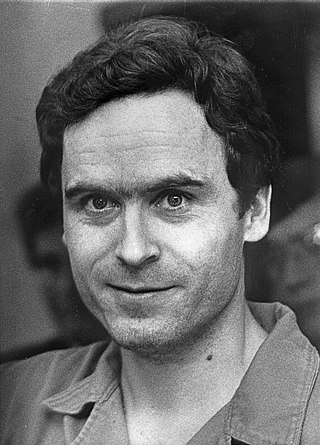Ted Bundy
American serial killer (1946–1989) From Wikipedia, the free encyclopedia
Remove ads
Theodore Robert "Ted" Bundy (November 24, 1946 - January 24, 1989) was an American serial killer, kidnapper, and rapist. He confessed to killing 30 women, although the actual number of murders committed is unknown.

Biography
Ted Bundy was born in 1946 in Burlington, Vermont, USA.[1] He lived with his mother Louise Cowell and grandfather Sam Cowell when he was a child.[1] Bundy and his mother moved to Washington where she married a man named John Culpepper Bundy.[1] As a child in Washington, Bundy was a good student and went to church often, yet he found it hard to make friends and he began stealing. As a young man, Bundy became involved in politics and got with a woman named Diane Edwards, known better by the pseudonym Stephanie Brooks. She left him, and he went on his own for a while. After seeing that he had improved, she got back together with him, but he proposed and left her a few days later. This is when the murders began. The people that Bundy would murder were much like this lady: young, white skinned (Caucasian), and with long dark hair parted in the middle.
Bundy's first known murders were in 1974 with his first known violent attack on January 4 when he crept into the room of an 18-year-old girl called Joni Lenz and beat her with a crowbar while she was asleep. He then sexually assaulted (raped) her with a metal rod that he took from the bed. She was found the next morning in a pool of blood. She was not killed but would remain in a coma and suffered brain damage (damage to the brain that stops the body from working properly). A few weeks later on January 31, Bundy broke into another woman's basement and beat her over the head. He then dressed her, wrapped her in blankets, and carried her away. She was found a year later in Seattle, Washington with no head. In between this time and June 1974, he killed eight more women in Washington. In June, he kidnapped Janice Ott and Denise Naslund from a park near Seattle. These attacks, unlike the attacks before, were in 'broad daylight' - in front of other people.
In the autumn Bundy moved to Utah[2] to begin studying law at the University of Utah.[3] He began killing again in October 1974. Bundy kidnapped and killed three girls in October 1974, one of them being the daughter of a police officer. On November 8, Bundy told a girl that he was a police officer and he told her to get in his car. She did, believing he really was a police officer. He then tried to handcuff her but she would not let him and she jumped out of the car and escaped. Bundy was angry that she had got away and so a few hours later he kidnapped another girl and killed her. Her body was never found. Bundy was still living in Utah in 1975 and was still attending law school but he began only killing people in Colorado. Bundy kidnapped and killed four women from Colorado and one more from Utah in the first half of 1975 (January to June).
On August 16, 1975, Bundy was arrested for not stopping his car when ordered to by a police officer.[4] When they searched his car they found a ski mask, a crowbar, handcuffs, trash bags, and other items that they thought he must have been using to burglarize houses. The police then noticed that his car was the car the girl who escaped had told them about. Bundy was sentenced on March 1, 1976, to fifteen years in prison for kidnapping her. Bundy escaped from the police twice in 1977 before he could be sentenced for the murders he had committed. By early 1978 he had made his way to Florida where he killed two more women and injured three others. After that he murdered a 12-year-old girl called Kimberley Leach. She was the last girl murdered by Bundy before he was stopped by a police officer on February 15, 1978.
Bundy had antisocial personality disorder. He went on trial on June 25 until July 31 for the murders he had committed. He was sentenced to 3 death sentences, and was going to be executed by the electric chair. In the time he was in prison and waiting to be executed he helped the police investigate other murders and in 1988 he admitted to having killed eight more women than he was tried for. Bundy was executed by the use of the electric chair at the Florida State Prison on January 24, 1989. He was 42 years old.
Remove ads
Copycat crimes
The perpetrators of the 2006 murder of Cassie Jo Stoddart cited Ted Bundy as one their idols and inspirations.[5]
References
Wikiwand - on
Seamless Wikipedia browsing. On steroids.
Remove ads
